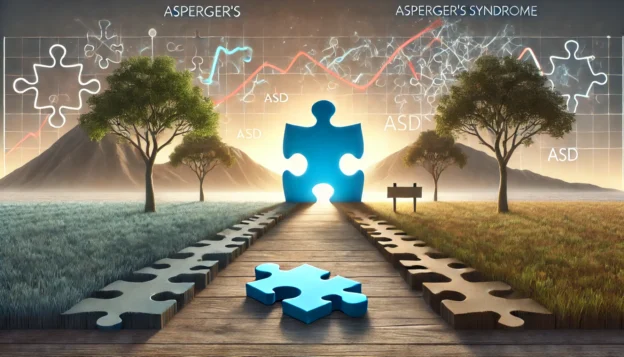Asperger’s Syndrome, described by Dr. Hans Asperger in 1944, is characterized by normal to high intelligence and strong language skills but significant social challenges. The DSM-IV recognized it as distinct from other autism spectrum disorders. However, the DSM-5 in 2013 merged Asperger’s into Autism Spectrum Disorder (ASD), citing shared characteristics. Critics argue this overlooks unique cognitive profiles, language development, and social interaction patterns specific to Asperger’s, necessitating tailored educational and behavioural interventions. Maintaining Asperger’s as a separate classification ensures individuals receive appropriate, specialized support, improving their outcomes.
Introduction
Asperger’s Syndrome, historically seen as a distinct condition within the autism spectrum, has unique characteristics that warrant separate classification. Despite its consolidation into Autism Spectrum Disorder (ASD) in the DSM-5, the differences in cognitive profiles, social needs, and support requirements suggest that Asperger’s Syndrome maintains enough uniqueness to be viewed independently. This article explores these distinctions and argues, based on research, for the continued recognition of Asperger’s Syndrome as a separate diagnostic category.
Historical Context and Diagnostic Criteria
Asperger’s Syndrome was first described by Austrian paediatrician Dr. Hans Asperger in 1944. He identified children with normal to high intelligence and strong language skills, but significant social and communication difficulties. The DSM-IV included Asperger’s Syndrome as a distinct diagnosis, characterized by:
- No significant delay in language development.
- Average to above-average intelligence.
- Marked difficulties in social interaction and restricted, repetitive behaviours and interests.
In contrast, Autism Spectrum Disorder encompasses a broader range of symptoms and severities, including language delays and intellectual disabilities. The DSM-5, published in 2013, merged Asperger’s Syndrome into ASD to reflect the spectrum nature of autism, emphasizing shared characteristics rather than distinctions.
Cognitive and Behavioral Differences
Research highlights notable cognitive and behavioural differences between individuals with Asperger’s Syndrome and those with other forms of ASD:
- Cognitive Profiles:
- Individuals with Asperger’s typically have average to above-average IQs and may excel in specific areas, such as mathematics or science. Studies have shown that these individuals often possess intense focus and expertise in particular subjects, contributing to the “little professor” stereotype associated with Asperger’s Syndrome.
- In contrast, individuals with ASD may have a broader range of cognitive abilities, including those with intellectual disabilities. This variability affects their learning and developmental outcomes, requiring different educational and support strategies.
- Language Development:
- One of the defining features of Asperger’s Syndrome is the absence of significant language delays. Children with Asperger’s often develop language skills at an early age and may exhibit advanced vocabulary and complex sentence structures. However, they might struggle with pragmatic language use, such as understanding humour, sarcasm, and social nuances.
- Many individuals with ASD experience delays in language acquisition and may require speech therapy and other interventions to develop functional communication skills.
- Social Interaction:
- Social challenges in Asperger’s Syndrome often manifest as difficulties in understanding and interpreting social cues, maintaining eye contact, and engaging in reciprocal conversations. Despite these challenges, individuals with Asperger’s generally have a desire for social interaction and may seek out friendships, although they might struggle to maintain them.
- In ASD, social interaction challenges can be more profound, with some individuals showing limited interest in social engagement and struggling with basic social reciprocity.
Support and Intervention Needs
The differences in cognitive profiles and social behaviours between Asperger’s Syndrome and other forms of ASD imply distinct support and intervention needs:
- Educational Support:
- Individuals with Asperger’s often benefit from educational environments that cater to their intellectual strengths while addressing social and pragmatic language skills. Programs that offer advanced coursework in areas of interest, coupled with social skills training, can be highly effective.
- For those with ASD, educational interventions may need to address a broader range of developmental and learning challenges, including individualized education plans (IEPs) that incorporate speech therapy, occupational therapy, and behavioural interventions.
- Social Skills Training:
- Social skills training for individuals with Asperger’s should focus on nuanced social interactions, such as understanding non-verbal cues, practising conversation skills, and developing strategies for forming and maintaining relationships.
- In ASD, social skills training may need to start with foundational social behaviours, including joint attention, basic communication skills, and initiating social interactions.
- Behavioural Interventions:
- While individuals with Asperger’s may exhibit restricted and repetitive behaviours, these behaviours are often less disruptive and may be channelled into productive interests. Behavioural interventions should focus on flexibility and coping strategies for managing change.
- Behavioural interventions for ASD often address a wider range of behaviours, including self-injurious actions and significant resistance to change, requiring more intensive and comprehensive approaches.
Conclusion
Despite the DSM-5’s consolidation of Asperger’s Syndrome into Autism Spectrum Disorder, the distinct cognitive profiles, language development patterns, social interaction challenges, and support needs highlight the unique nature of Asperger’s. Recognizing Asperger’s Syndrome as a separate classification can ensure that individuals receive tailored interventions and support that address their specific strengths and challenges. This distinction can lead to more effective educational strategies, targeted social skills training, and appropriate behavioural interventions, ultimately improving outcomes for individuals with Asperger’s Syndrome.
References
- Inter-individual cognitive variability in children with Asperger’s syndrome
- Asperger’s syndrome and high-functioning autism: language, motor and cognitive profiles
- Defining the Intellectual Profile of Asperger Syndrome: Comparison with High-Functioning Autism
- Theory of Mind Profiles in Children With Autism Spectrum Disorder: Adaptive/Social Skills and Pragmatic Competence
- Effectiveness of social skills training for individuals with Asperger’s syndrome
- Behavioral interventions for repetitive behaviors in autism
- Behavioral, Cognitive and Neural Markers of Asperger Syndrome
- Educational Strategies to Address the Educational Needs of Students with Asperger Syndrome in the Mainstream Classroom
